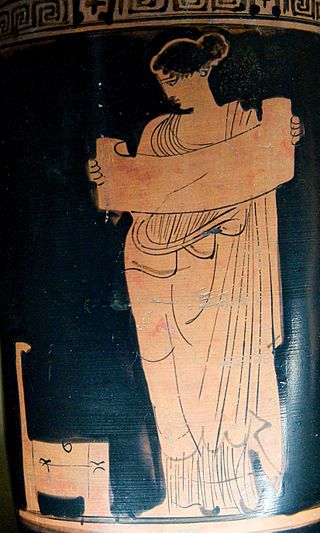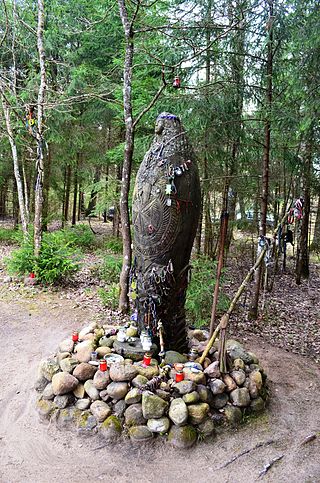Related Research Articles

Ares is the Greek god of war and courage. He is one of the Twelve Olympians, and the son of Zeus and Hera. The Greeks were ambivalent towards him. He embodies the physical valor necessary for success in war but can also personify sheer brutality and bloodlust, in contrast to his sister, the armored Athena, whose martial functions include military strategy and generalship. An association with Ares endows places, objects, and other deities with a savage, dangerous, or militarized quality.

A goddess is a female deity. In many known cultures, goddesses are often linked with literal or metaphorical pregnancy or imagined feminine roles associated with how women and girls are perceived or expected to behave. This includes themes of spinning, weaving, beauty, love, sexuality, motherhood, domesticity, creativity, and fertility. Many major goddesses are also associated with magic, war, strategy, hunting, farming, wisdom, fate, earth, sky, power, laws, justice, and more. Some themes, such as discord or disease, which are considered negative within their cultural contexts also are found associated with some goddesses. There are as many differently described and understood goddesses as there are male, shapeshifting, or neuter gods.

In ancient Greek religion and mythology, the Muses are the inspirational goddesses of literature, science, and the arts. They were considered the source of the knowledge embodied in the poetry, lyric songs, and myths that were related orally for centuries in ancient Greek culture.

Marija Gimbutas was a Lithuanian archaeologist and anthropologist known for her research into the Neolithic and Bronze Age cultures of "Old Europe" and for her Kurgan hypothesis, which located the Proto-Indo-European homeland in the Pontic Steppe.
In Latvian mythology, the term Māte stands for "mother", sometimes written in English as Mahte. It was an epithet applied to some sixty-seventy goddesses. They were clearly distinct goddesses in most or all cases, so the term definitely referred to the mother-goddess of specific phenomena. According to professor Lotte Motz, scholar Haralds Biezais mentioned there were at least 70 characters in Baltic religion identified with the title of Mate.

Zorya is a figure in Slavic folklore, a feminine personification of dawn, possibly goddess. Depending on tradition, she may appear as a singular entity, often called "The Red Maiden", or two or three sisters at once. Although Zorya is etymologically unrelated to the Proto-Indo-European goddess of the dawn *H₂éwsōs, she shares most of her characteristics. She is often depicted as the sister of the Sun, the Moon, and Zvezda, the Morning Star with which she is sometimes identified. She lives in the Palace of the Sun, opens the gate for him in the morning so that he can set off on a journey through the sky, guards his white horses, she is also described as a virgin. In the Eastern Slavic tradition of zagovory she represents the supreme power that a practitioner appeals to.
The Triple Goddess is a deity or deity archetype revered in many Neopagan religious and spiritual traditions. In common Neopagan usage, the Triple Goddess is viewed as a triunity of three distinct aspects or figures united in one being. These three figures are often described as the Maiden, the Mother, and the Crone, each of which symbolizes both a separate stage in the female life cycle and a phase of the Moon, and often rules one of the realms of heavens, earth, and underworld. In various forms of Wicca, her masculine consort is the Horned God.

Proto-Indo-European mythology is the body of myths and deities associated with the Proto-Indo-Europeans, speakers of the hypothesized Proto-Indo-European language. Although the mythological motifs are not directly attested – since Proto-Indo-European speakers lived in preliterate societies – scholars of comparative mythology have reconstructed details from inherited similarities found among Indo-European languages, based on the assumption that parts of the Proto-Indo-Europeans' original belief systems survived in the daughter traditions.

Žemyna is the goddess of the earth in Lithuanian religion. She is usually regarded as mother goddess and one of the chief Lithuanian gods similar to Latvian Zemes māte. Žemyna personifies the fertile earth and nourishes all life on earth, human, plant, and animal. All that is born of earth will return to earth, thus her cult is also related to death. As the cult diminished after baptism of Lithuania, Žemyna's image and functions became influenced by the cult of Virgin Mary.

The Goddess movement is a revivalistic Neopagan religious movement which includes spiritual beliefs and practices that emerged predominantly in the Western world during the 1970s. The movement grew as a reaction both against Abrahamic religions, which exclusively have gods with whom are referred by masculine grammatical articles and pronouns, and secularism. It revolves around Goddess worship and the veneration for the divine feminine, and may include a focus on women or on one or more understandings of gender or femininity.

In Greek mythology, a little owl traditionally represents or accompanies Athena, the virgin goddess of wisdom, or Minerva, her syncretic incarnation in Roman mythology. Because of such association, the bird—often referred to as the "owl of Athena" or the "owl of Minerva"—has been used as a symbol of knowledge, wisdom, perspicacity and erudition throughout the Western world.
In Zoroastrianism, Spənta Ārmaiti is one of the Amesha Spentas, the seven divine manifestations of Wisdom and Ahura Mazda. While older sources present the Amesha Spentas more as abstract entities, in later sources Spenta Armaiti is personified as a female divinity with connotations of harmony and devotion.

In ancient Roman religion and mythology, Mars is the god of war and also an agricultural guardian, a combination characteristic of early Rome. He is the son of Jupiter and Juno, and was pre-eminent among the Roman army's military gods. Most of his festivals were held in March, the month named for him, and in October, the months which traditionally began and ended the season for both military campaigning and farming.

The gods and goddesses of the pre-Christian Celtic peoples are known from a variety of sources, including ancient places of worship, statues, engravings, cult objects, and place or personal names. The ancient Celts appear to have had a pantheon of deities comparable to others in Indo-European religion, each linked to aspects of life and the natural world. Epona was an exception and retained without association with any Roman deity. By a process of syncretism, after the Roman conquest of Celtic areas, most of these became associated with their Roman equivalents, and their worship continued until Christianization. Pre-Roman Celtic art produced few images of deities, and these are hard to identify, lacking inscriptions, but in the post-conquest period many more images were made, some with inscriptions naming the deity. Most of the specific information we have therefore comes from Latin writers and the archaeology of the post-conquest period. More tentatively, links can be made between ancient Celtic deities and figures in early medieval Irish and Welsh literature, although all these works were produced well after Christianization.
Medeina or Medeinė, often treated as synonymous to Žvorūnė or Žvorūna, is one of the main deities in the Lithuanian mythology, and is similar to Latvian Meža māte. She is a ruler of forests, trees and animals. Her sacred animal is a hare.

Roman mythology is the body of myths of ancient Rome as represented in the literature and visual arts of the Romans. One of a wide variety of genres of Roman folklore, Roman mythology may also refer to the modern study of these representations, and to the subject matter as represented in the literature and art of other cultures in any period. Roman mythology draws from the mythology of the Italic peoples and ultimately from Proto-Indo-European mythology.
The Moles are goddesses who appear in an ancient Roman prayer formula in connection with Mars. The list of invocations given by Aulus Gellius pairs a god's name with a feminine nominative noun that personifies a quality or power of the god (Moles Martis, "Moles of Mars"). These pairings are often taken as "marriages" in the anthropomorphic mythological tradition. An inscription records a supplicatio Molibus Martis, supplication for the Moles of Mars.
The Enarei, singular Enaree, were Scythian androgynous/effeminate priests and shamanistic soothsayers who played an important role in the Scythian religion.
References
- ↑ Dexter, Miriam Robbins. Whence the goddesses: a source book. The Athene Series. New York and London: Teachers College Press, Teachers College, Columbia University. 1990. p. 154. ISBN 0-8077-6234-2.
- ↑ Grimal, p. 308.
- ↑ Woodard, Roger D. "The Minor Capitoline Triad". In: Indo-European Sacred Space: Vedic and Roman Cult. University of Illinois Press, 2006. pp. 21 and 112-114. Accessed September 17, 2020. http://www.jstor.org/stable/10.5406/j.ctt1xcmv6.5.
- ↑ Mallory, J. P.; Adams, Douglas Q. (1997). Encyclopedia of Indo-European culture. Taylor & Francis. p. 596. ISBN 978-1-884964-98-5.
- ↑ Dexter, Miriam Robbins. Whence the goddesses: a source book. The Athene Series. New York and London: Teachers College Press, Teachers College, Columbia University. 1990. p. 154. ISBN 0-8077-6234-2.
